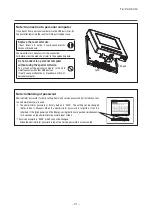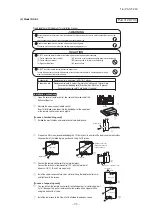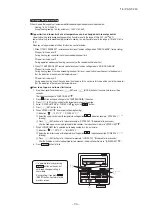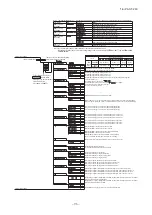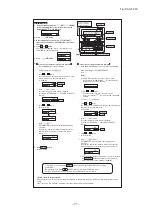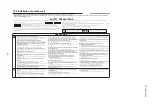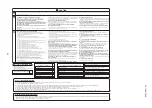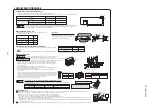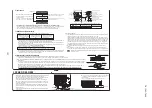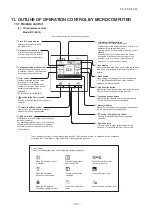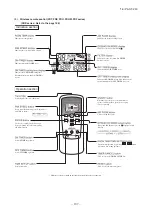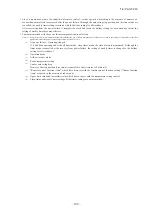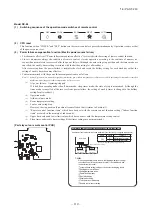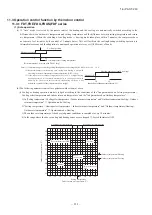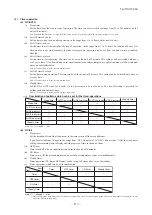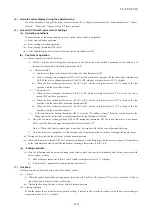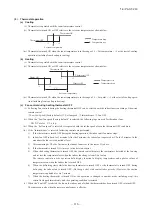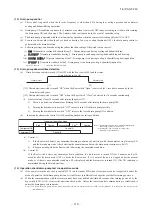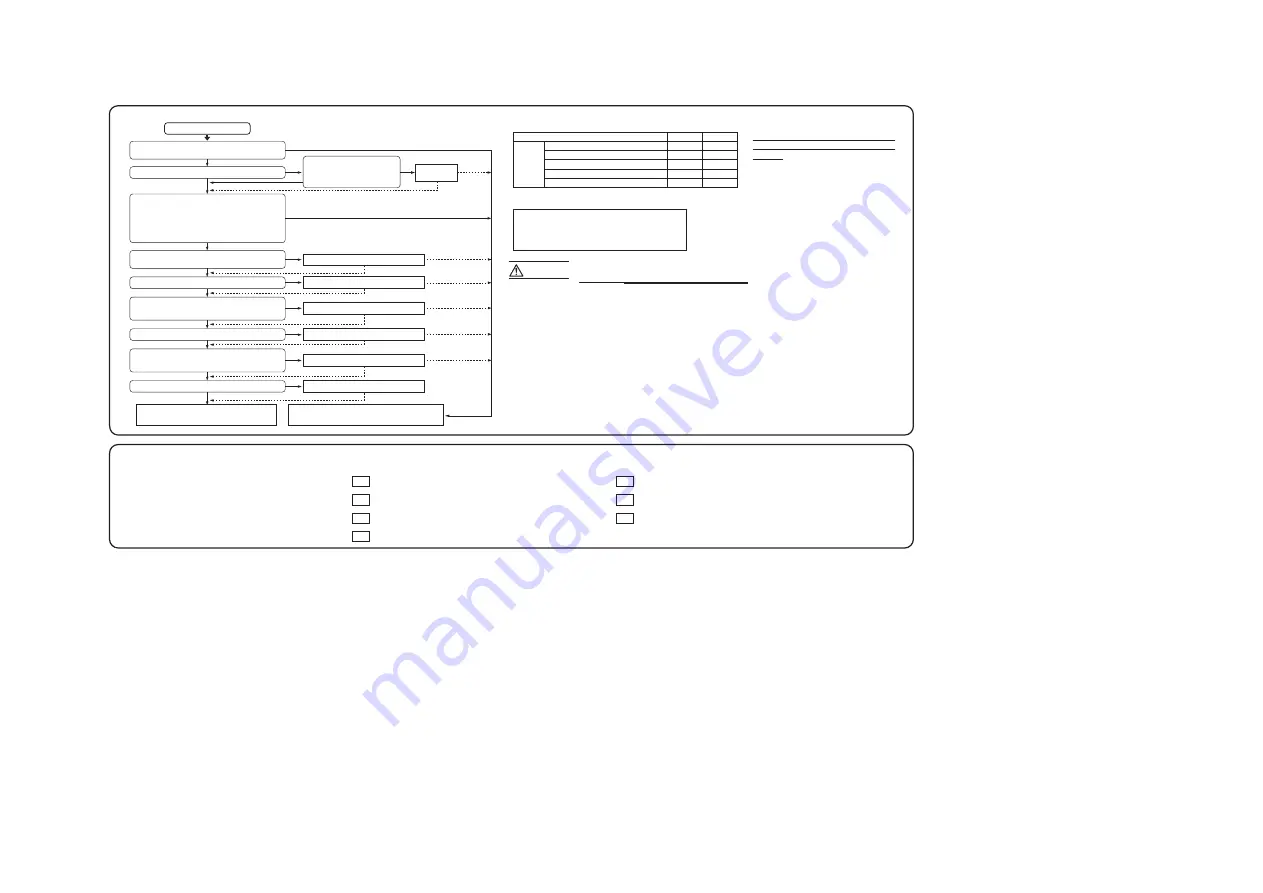
-
104
-
'16 • P
A
C-T
-240
Drain elbow
Grommet
Grommet
Drain hose
(Grommet, Drain elbow and Drain hose are procured on the installer’s part)
Charge hose
(Designed specifically for R410A)
Compound pressure gauge
Pressure gauge
Gauge manifold
(Designed specifically for R410A)
Handle Hi
Vacuum pump
Vacuum pump adapter
(Anti-reverse flow type)
(Designed specifically for R410A)
Charge hose
(Designed specifically for R410A)
Check joint
-0.1MPa
(-76cmHg)
Handle Lo
Service valve
(Liguid side)
Service valve cap
Service valve
(Gas side)
Wires for connecting indoor
and outdoor units
Exterior tape
Gas piping
Insulation
Liquid piping
Band (procured locally)
Pipe cover (procured locally)
8) Heating and condensation prevention
Take care so that installed pipes may not touch components within a unit.
If pipes touch internal components, abnormal sounds and/or vibrations.
4) On-site piping work
IMPORTANT
How to remove the side cover
A
B
Flared pipe end : A
(mm)
ø9.52
ø15.88
Copper pipe
outer diameter
0
A –04
013.2
19.7
ø9.52
ø15.88
Copper pipe
outer diameter
0 0.5
1.0 1.5
Copper pipe protrusion for flaring : B
(mm)
In the case of a rigid (clutch) type
With an R410A tool With a conventional tool
CAUTION
Do not apply force beyond proper fastening torque in tightening the flare nut.
Tightening angle (˚)
Tightening torque (N·m)
ø9.52 (3/8")
ø15.88 (5/8")
Recommended length of a tool handle (mm)
Service valve size (mm)
5) Air tightness test
Gas side
service valve
Check joint
Pressurize
Close
Outdoor unit
Indoor unit
<Work flow>
6) Evacuation
Pay attention to the following points in addition to the above for the R410A and compatible machines.
Air tightness test completed
Fill refrigerant
Vacuum gauge check
Vacuuming completed
Vacuuming begins
3) Refrigerant pipe wall thickness and material
NOTE
*Phosphorus deoxidized seamless copper pipe ICS 23.040.15, ICS 77.150.30
ø9.52
0.8
O-type pipe
ø15.88
1.0
O-type pipe
Pipe diameter [mm]
Minimum pipe wall thickness [mm]
Pipe material*
• Select refrigerant pipes of the table shown on the right wall thickness and material as specified
for each pipe size.
Although outdoor and indoor units themselves have been tested for air tightness at the factory, check the connecting pipes after the installation work for air tightness from the service
valve’s check joint equipped on the outdoor unit side. While conducting a test, keep the service valve shut all the time.
a) Raise the pressure to 0.5MPa, and then stop. Leave it for five minutes to see if the pressure drops.
b) Then raise the pressure to 1.5MPa, and stop. Leave it for five more minutes to see if the pressure drops.
c) Then raise the pressure to the specified level (4.15MPa), and record the ambient temperature and the pressure.
d) If no pressure drop is observed with an installation pressurized to the specified level and left for about one day, it is acceptable. When the ambient temperature fall 1C, the pressure also
fall approximately 0.01MPa. The pressure, if changed, should be compensated for.
e) If a pressure drop is observed in checking e) and a) – d), a leak exists somewhere. Find a leak by applying bubble test liquid to welded parts and flare joints and repair it. After repair,
conduct an air tightness test again.
In conducting an air tightness test, use nitrogen gas and pressurize the system with nitrogen gas from the gas side. Do not use a medium other than nitrogen gas under any circumstances.
• The pipe can be laid in any of the following directions: side right, front, rear and downward.
• Remove a knock-out plate provided on the pipe penetration to open a minimum necessary area
and attach an edging material supplied as an accessory by cutting it to an appropriate length
before laying a pipe.
• Carry out the on site piping work with the service valve fully closed.
• Give sufficient protection to a pipe end (compressed and blazed, or with an adhesive tape) so that
water or foreign matters may not enter the piping.
• Bend a pipe to a radius as large as practical (R100 R150). Do not bend a pipe repeatedly to
correct its form.
• Flare connection is used between the unit and refrigerant pipe. Flare a pipe after engaging a flare
nut onto it. Flare dimensions for R410A are different from those for conventional R407C. Although
we recommend the use of flaring tools designed specifically for R410A, conventional flaring tools
can also be used by adjusting the measurement of protrusion B with a protrusion control gauge.
• The pipe should be anchored every 1.5m or less to isolate the vibration.
• Tighten the flare joint securely with a double spanner.
• To prevent a different oil from entering, use dedicated tools, etc. to each refrigerant type. Under no circumstances must a
gauge manifold and a charge hose in particular be shared with other refrigerant types (R22, R407C, etc.).
• Use a counterflow prevention adapter to prevent vacuum pump oil from entering the refrigerant system.
• This unit contains factory charged refrigerant covering 15m of refrigerant piping and additional refrigerant charge on
the installation site is not required for an installation with up to 15m refrigerant piping.
When refrigerant piping exceeds 15m, additionally charge an amount calculated from the pipe length and the above
table for the portion in excess of 15m.
• If an existing pipe system is used, required refrigerant charge volume will vary depending on the liquid pipe size. For
further information, see “5. UTILIZATION OF EXISTING PIPING.”
* When an additional charge volume calculation result is negative, it is not necessary to charge refrigerant additionally.
• For an installation measuring 15m or shorter in pipe length, charge the refrigerant volume charged for shipment at
the factory, when you recharge refrigerant after servicing etc.
Fix both liquid and gas service valves at the valve main bodies as illustrated on the right, and then fasten them,
applying appropriate fastening torque.
Select pipes having a wall thickness larger than the specified minimum pipe thickness.
34
-
42
68 82
30 45
15 20
200
300
1
2
Run the vacuum pump for at least one hour after the vacuum
gauge shows –0.1MPa or lower. (–76cmHg or lower)
When the system has remaining moisture
inside or a leaky point, the vacuum gauge
indicator will rise.
Check the system for a leaky point and
then draw air to create a vacuum again.
Confirm that the vacuum gauge indicator does not rise even if
the system is left for one hour or more.
Service valve cap
tightening torque (N·m)
Check joint blind nut
tightening torque (N·m)
ø9.52 (3/8")
ø15.88 (5/8")
20 30
30 40
10 12
Service valve size
(mm)
Securely tighten the service valve cap and the check joint blind nut after adj ustment.
(1) Dress refrigerant pipes (both gas and liquid pipes) for heat insulation and prevention of dew condensation.
• Improper heat insulation/anti-dew dressing can result in a water leak or dripping causing damage to household effects, etc.
(2) Use a heat insulating material that can withstand 120˚C or a higher temperature. Poor heat insulating capacity can cause heat insulation problems or cable
deterioration.
• All gas pipes must be securely heat insulated in order to prevent damage from dripping water that comes from the condensation formed on them during a cooling
operation or personal injury from burns because their surface can reach quite a high temperature due to discharged gas flowing inside during a heating operation.
• Wrap indoor units’ flare joints with heat insulating parts (pipe cover) for heat insulation (both gas and liquid pipes).
• Give heat insulation to both gas and liquid side pipes. Bundle a heat insulating material and a pipe tightly together so that no gaps may be left between them and
wrap them together with a connecting cable by a dressing tape.
• Both gas and liquid pipes need to be dressed with 20mm or thicker heat insulation materials above the ceiling where relative humidity exceeds 70%.
(1) Calculate a required refrigerant charge volume from the following table.
Formula to calculate the volume of additional refrigerant required
7) Additional refrigerant charge
Additional charge volume (g) = { Main length (m) – Factory charged volume 15 (m) } x 60 (g/m)
60
2.55
15
Put down the refrigerant volume calculated from the pipe length onto the caution label attached
on the service panel.
• Since R410A refrigerant must be charged in the liquid phase, you should charge it keeping the container
cylinder upside down or using a refrigerant cylinder equipped with a siphon tube.
• Charge refrigerant always from the liquid side service port with the service valve shut. When you find it
difficult to charge a required amount, fully open the outdoor unit valves on both liquid and gas sides and
charge refrigerant from the gas (suction) side service port, while running the unit in the cooling mode. In
doing so, care must be taken so that refrigerant may be discharged from the cylinder in the liquid phase
all the time. When the cylinder valve is throttled down or a dedicated conversion tool to change liquid
phase refrigerant into mist is used to protect the compressor, however, adjust charge conditions so that
refrigerant will gasify upon entering the unit.
• In charging refrigerant, always charge a calculated volume by using a scale to measure the charge
volume.
• When refrigerant is charged with the unit being run, complete a charge operation within 30minutes.
Running the unit with an insufficient quantity of refrigerant for a long time can cause a compressor failure.
(2) Charging refrigerant
NOTE
Additional charge volume (g)
per meter of refrigerant piping
(liquid pipe ø9.52)
Refrigerant volume charged
for shipment at the factory
(kg)
Installation’s pipe length (m)
covered without additional
refrigerant charge
4. ELECTRICAL WIRING WORK
For details of electrical cabling, refer to the indoor unit installation manual.
H
05
R
N
R
4or5
G
1.5
Harmonized cable type
300/500 volts
Natural-and/or synth. rubber wire insulation
Polychloroprene rubber conductors insulation
Stranded core
Number of conductors
One conductor of the cable is the earth conductor
(yellow/green)
Section of copper wire (mm
2
)
H05RNR4G1.5 (Example) or 245IEC57
Electrical installation work must be performed by an electrical installation service provider qualified by a power provider of the country.
Electrical installation work must be executed according to the technical standards and other regulations applicable to electrical installations in the country.
• Do not use any power cable lighter than one specified in parentheses for each type below.
• braided cord (code designation 60245 IEC 51)
• ordinary tough rubber sheathed cord (code designation 60245 IEC 53)
• flat twin tinsel cord (code designation 60227 IEC 41)
Use polychloroprene sheathed flexible cord (code designation 60245 IEC57) for power
cables of parts of appliances for outdoor use.
• Ground the unit. Do not connect the grounding wire to a gas pipe, water pipe, lightning rod
or telephone grounding wire.
If improperly grounded, an electric shock or malfunction may result.
• A grounding wire must be connected before connecting the power cable. Provide a
grounding wire longer than the power cable.
• The installation of an impulse withstanding type earth leakage breaker is necessary.
A failure to install an earth leakage breaker can result in an accident such as an electric
shock or a fire.
• Do not turn on the power until the electrical work is completed.
• Do not use a condensive capacitor for power factor improvement under any circumstances.
(It dose not improve power factor, while it can cause an abnormal overheat accident)
• For power cables, use conduits.
• Do not lay electronic control cables (remote control and signaling wires)
and other cables together outside the unit. Laying them together can
result in the malfunctioning or a failure of the unit due to electric noises.
• Fasten the cables so that those may not touch the piping, etc.
• When cables are connected, make sure that all electrical components
within the electrical component box are free of loose connector coupling
or terminal connection and then attach the cover securely. (Improper
cover attachment can result in malfunctioning or a failure of the unit, if
water penetrates into the box.)
• Never use a shield cable.
• Always use a three-core cable for an indoor-outdoor connecting cable.
Never use a shield cable.
• Connect a pair bearing a common terminal number with an
indoor-outdoor connecting wire.
• In cabling, fasten cables securely with cable clamps so that no external
force may work on terminal connections.
CAUTION
• The specifications shown in the above table are for units without heaters. For units with heaters, refer to
the installation instructions or the construction instructions of the indoor unit.
• Switchgear or Circuit breaker capacity which is calculated from maximum over current should be chosen
along the regulations in each country.
• The cable specifications are based on the assumption that a metal or plastic conduit is used with no more
than three cables contained in a conduit and a voltage drop is 2%. For an installation falling outside of
these conditions, follow the internal cabling regulations. Adapt it to the regulation in effect in each country.
<Table of pipe size restrictions>
◎
: Standard pipe size
○
: Usable
△
: Restricted to shorter pipe length limits
Additional charge volume (g) =
{Main pipe length (m) - Length covered without additional
charge shown in the table (m)} X Additional charge volume
per meter of pipe shown in the table (g/m)
Formula to calculate additional charge volume
NO
Are the existing units our products?
NO
NO
NO
NO
NO
NO
Is the existing pipe system to reuse free of corrosion, flaws or dents?
Repair the damaged parts.
Remove those branches.
Repair the damaged parts.
Check the pipe system for air tightness on the site.
Repair the damaged parts.
No loose pipe supports
NO
YES
START
The existing pipe system is reusable.
The existing pipe system is not reusable.
Install a new pipe system.
YES
YES
YES
YES
YES
Are an outdoor unit and an indoor unit connected to the
existing pipe system to reuse?
Is the unit to install in the existing pipe system a
twin-triple-double-twin model?
Is the existing pipe system to reuse free of gas leaks?
(Check whether refrigerant charge was required frequently for
the system before)
Are heat insulation materials of the existing pipe system to
reuse free of peel-offs or deterioration?
(Heat insulation is necessary for both gas and liquid pipes)
Change the branching pipe to a specified type.
Does the existing pipe system to reuse satisfy all of the following?
(1) The pipe length is 30m or less.
(2) The pipe size conforms to the table of pipe size restrictions.
(3) The elevation difference between the indoor and outdoor units
conforms to the following restrictions.
Where the outdoor unit is above: 20m or less
Where the outdoor unit is below: 20m or less
Which of the following refrigeration oils
does the existing unit use?
Suniso, MS, Barrel Freeze, HAB, Freol,
ether oil, ester oil
Make an inquiry
for reusability.
Change
Change is impossible.
Can Use
Can not Use
Repair is impossible.
Air tightness is impossible.
Remove is impossible.
Repair is impossible.
Repair
Repair
Repair
Some loose pipe supports
Air tightness is OK
Remove
Check whether an existing pipe system is reusable or not by using the following flow chart.
Are not there any loose pipe supports?
Are there any branch pipes with no indoor unit connected?
NO
※
If you obtain a negative figure as a result of calculation, no additional
refrigerant needs to be charged.
Example) When an FDC100 is installed in a 10m long existing pipe
system (liquid ø12.7, gas ø15.88), the quantity of refrigerant
to charge additionally should be (10m-7m) x 80g/m = 240g.
<Where the existing unit can be run for a cooling operation.>
Carry out the following steps with the excising unit (in the order of (1), (2), (3) and (4))
(1) Run the unit for 30 minutes for a cooling operation.
(2) Stop the indoor fan and run the unit for 3 minutes for a cooling operation (returning liquid)
(3) Close the liquid side service valve of the outdoor unit and pump down (ref rigerant recovery)
(4) Blow with nitrogen gas.
※
If discolored refrigeration oil or any foreign matters is discharged by
the blow, wash the pipe system or install a new pipe system.
• For the flare nut, do not use the old one, but use the one supplied with the outdoor unit.
Process a flare to the dimensions specified for R410A.
<Where the existing unit cannot be run for a cooling operation.>
Wash the pipe system or install a new pipe system.
• If you choose to wash the pipe system, contact our distributor in the area.
WARNING
※
Check with the flow chart developed for a case
where an existing pipe system is reused for a
twin-triple-double-twin model published as a
technical data sheet.
Always use an earth leakage circuit breaker designed for inverter circuits to prevent
a faulty operation.
Use cables for interconnection wiring to avoid loosening of the
wires. CENELEC code for cables Required field cables.
In case of faulty wiring connection, indoor unit dose not
operate. Then, run lamp turns on and timer lamp blinks.
INSTALLATION TEST CHECK
POINTS
After installation
Power cables and connecting wires are securely fixed to the terminal block.
The power source voltage is correct as the rating.
The drain hose is fixed securely.
Service valve is fully open.
No gas leaks from the joints of the service valve.
The pipe joints for indoor and outdoor pipes have been insulated.
The screw of the side cover is tightened securely.
Check the following points again after completion of the
installation, and before turning on the power. Conduct a test run
again and ensure that the unit operates properly.
Explain to the customer how to use the unit and how to take care
of the unit following the instruction manual.
5. UTILIZATION OF EXISTING PIPING
Main fuse specification
250V 20A
Specification
Part No.
SSA564A136A
Liquid pipe
Gas pipe
Usability
Maximum one-way pipe length
Length covered without additional charge
Pipe size
Additional charge volume per meter of pipe
60g/m
ø9.52
ø15.88
◎
30
15
80g/m
ø12.7
ø15.88
△
15
7
• Consult with our distributor in the area, if
you need to recover refrigerant and charge
it again.
• Any combinations of pipe sizes not listed in
the table are not usable.
First remove the five screws ( mark) of the service panel and push it down into
the direction of the arrow mark and then remove it by pulling it toward you.
Do not hold the valve cap area with a spanner.
Use a torque wrench. If a torque wrench is not
available, fasten the flare nut manually first and then
tighten it further, using the left table as a guide.
For downward connection
For side right connection
For front connection
For rear connection
Edging
(For knock-out hole protection)
When change the Printed circuit board,
take off the top panel.
How to remove the top panel
Remove the screws of the top panel.
Screw x11
L1
Outdoor unit
Switchgear or Circuit breaker
N
1 2/N 3
1 2/N 3
Indoor unit
X
Y
X
Y Remote control
Earth leakage breaker
(Harmonic resistant type)
○
×
VCT cabtyre cable
VVF flat cable
4-core cable
Shield cable
5.5
21
25
ф
1.6
ф
1.6x3
Single phase 3 wire
220-240V 50Hz
220V 60Hz
Power source
Power cable thickness (mm
2
) MAX. over current (A) Cable length (m) Grounding wire thickness Indoor -outdoor wire thickness × number
5.5
22
24
ф
1.6
ф
1.6x3
Single phase 3 wire
220-240V 50Hz
220V 60Hz
Power source
Power cable thickness (mm
2
) MAX. over current (A) Cable length (m) Grounding wire thickness Indoor -outdoor wire thickness × number
At the connection with the duct type indoor unit.
Catch
3. DRAIN PIPING WORK
• Execute drain piping by using a drain elbow and drain grommets supplied separately
as accessories, where water drained from the outdoor unit is a problem.
• Water may drip where there is a larger amount of drain water. Seal around the drain
elbow and drain grommets with putty or adequate caulking material.
• Condensed water may flow out from vicinity of service valve or connected pipes.
• Where you are likely to have several days of sub-zero temperatures in a row, do not
use a drain elbow and drain grommets. (There is a risk of drain water freezing inside
and blocking the drain.)
• Do not use drain elbow and grommet made of plastic for drain piping when base
heater for outdoor unit is used. Plastic grommet and elbow will be damaged and
burnt in worst case.
• Prepare another drain tray made of metallic material for collecting drain when base
heater is used.
Power cable, indoor-outdoor connecting wires
(POWER CABLE)
CENELEC code for cables requiring fields cables.
H05RNR3G5.5
•
Always perform grounding system installation work with
the power cable unplugged.
•
Connect a pair bearing a common terminal number with
an indoor-outdoor connecting wire.
•
In cabling, fasten cables securely with cable clamps so that
no external force may work on terminal connections.
•
Grounding terminals are provided in the terminal block.
•
Use Polychloroprene sheathed flexible cord (code designation
60245 IEC57, IEC60335-2-40) with cross-sectional area of
5.5 mm
2
for power cable of outdoor unit.
Clearance
CAUTION
Indoor - Outdoor
connecting wire
Power cable
• Earth wire shall be
Yellow/Green (Y/G) in
color and longer than
other AC wires for
safety reason.
Grounding terminal
• Be sure to carry out grounding work.
• When condensed water needs to be led to a drain, etc., install the unit
on a flat base (supplied separately as a locally procured part) or
concrete blocks.
Then, secure space for the drain elbow and the drain hose.
• This clamp holds the indoor - outdoor connecting wire.
Wiring diagram
Cable clamp
• It holds cables in place and protect the terminal connection
from external force.
• This clamp is for the cable in the outside diameter 9 15mm.
Adjust it when not suitable.
• This clamp holds the power cable .
• It has stuck on the lid of a control box.
Cable clamp
Power cable, indoor - outdoor connecting wire circuit diagram
Power source terminal block
Connect the earthed line of indoor
and outdoor connecting wire to a
bracket part of the illustration.
EARTHING WORK
• Earth work shall be carried out without fail in order
to prevent electric shock and noise generation.
• The connection of the earth cable to the following
substances causes dangerous failures, therefore it
shall never be done. (City water pipe, Town gas
pipe, TV antenna, lightning conductor,
telephoneline, etc.)
-
-
-
-
-
-
-
-
-
-
Drain elbow
Grommet
Grommet
Drain hose
(Grommet, Drain elbow and Drain hose are procured on the installer’s part)
Charge hose
(Designed specifically for R410A)
Compound pressure gauge
Pressure gauge
Gauge manifold
(Designed specifically for R410A)
Handle Hi
Vacuum pump
Vacuum pump adapter
(Anti-reverse flow type)
(Designed specifically for R410A)
Charge hose
(Designed specifically for R410A)
Check joint
-0.1MPa
(-76cmHg)
Handle Lo
Service valve
(Liguid side)
Service valve cap
Service valve
(Gas side)
Wires for connecting indoor
and outdoor units
Exterior tape
Gas piping
Insulation
Liquid piping
Band (procured locally)
Pipe cover (procured locally)
8) Heating and condensation prevention
Take care so that installed pipes may not touch components within a unit.
If pipes touch internal components, abnormal sounds and/or vibrations.
4) On-site piping work
IMPORTANT
How to remove the side cover
A
B
Flared pipe end : A
(mm)
ø9.52
ø15.88
Copper pipe
outer diameter
0
A –04
013.2
19.7
ø9.52
ø15.88
Copper pipe
outer diameter
0 0.5
1.0 1.5
Copper pipe protrusion for flaring : B
(mm)
In the case of a rigid (clutch) type
With an R410A tool With a conventional tool
CAUTION
Do not apply force beyond proper fastening torque in tightening the flare nut.
Tightening angle (˚)
Tightening torque (N·m)
ø9.52 (3/8")
ø15.88 (5/8")
Recommended length of a tool handle (mm)
Service valve size (mm)
5) Air tightness test
Gas side
service valve
Check joint
Pressurize
Close
Outdoor unit
Indoor unit
<Work flow>
6) Evacuation
Pay attention to the following points in addition to the above for the R410A and compatible machines.
Air tightness test completed
Fill refrigerant
Vacuum gauge check
Vacuuming completed
Vacuuming begins
3) Refrigerant pipe wall thickness and material
NOTE
*Phosphorus deoxidized seamless copper pipe ICS 23.040.15, ICS 77.150.30
ø9.52
0.8
O-type pipe
ø15.88
1.0
O-type pipe
Pipe diameter [mm]
Minimum pipe wall thickness [mm]
Pipe material*
• Select refrigerant pipes of the table shown on the right wall thickness and material as specified
for each pipe size.
Although outdoor and indoor units themselves have been tested for air tightness at the factory, check the connecting pipes after the installation work for air tightness from the service
valve’s check joint equipped on the outdoor unit side. While conducting a test, keep the service valve shut all the time.
a) Raise the pressure to 0.5MPa, and then stop. Leave it for five minutes to see if the pressure drops.
b) Then raise the pressure to 1.5MPa, and stop. Leave it for five more minutes to see if the pressure drops.
c) Then raise the pressure to the specified level (4.15MPa), and record the ambient temperature and the pressure.
d) If no pressure drop is observed with an installation pressurized to the specified level and left for about one day, it is acceptable. When the ambient temperature fall 1C, the pressure also
fall approximately 0.01MPa. The pressure, if changed, should be compensated for.
e) If a pressure drop is observed in checking e) and a) – d), a leak exists somewhere. Find a leak by applying bubble test liquid to welded parts and flare joints and repair it. After repair,
conduct an air tightness test again.
In conducting an air tightness test, use nitrogen gas and pressurize the system with nitrogen gas from the gas side. Do not use a medium other than nitrogen gas under any circumstances.
• The pipe can be laid in any of the following directions: side right, front, rear and downward.
• Remove a knock-out plate provided on the pipe penetration to open a minimum necessary area
and attach an edging material supplied as an accessory by cutting it to an appropriate length
before laying a pipe.
• Carry out the on site piping work with the service valve fully closed.
• Give sufficient protection to a pipe end (compressed and blazed, or with an adhesive tape) so that
water or foreign matters may not enter the piping.
• Bend a pipe to a radius as large as practical (R100 R150). Do not bend a pipe repeatedly to
correct its form.
• Flare connection is used between the unit and refrigerant pipe. Flare a pipe after engaging a flare
nut onto it. Flare dimensions for R410A are different from those for conventional R407C. Although
we recommend the use of flaring tools designed specifically for R410A, conventional flaring tools
can also be used by adjusting the measurement of protrusion B with a protrusion control gauge.
• The pipe should be anchored every 1.5m or less to isolate the vibration.
• Tighten the flare joint securely with a double spanner.
• To prevent a different oil from entering, use dedicated tools, etc. to each refrigerant type. Under no circumstances must a
gauge manifold and a charge hose in particular be shared with other refrigerant types (R22, R407C, etc.).
• Use a counterflow prevention adapter to prevent vacuum pump oil from entering the refrigerant system.
• This unit contains factory charged refrigerant covering 15m of refrigerant piping and additional refrigerant charge on
the installation site is not required for an installation with up to 15m refrigerant piping.
When refrigerant piping exceeds 15m, additionally charge an amount calculated from the pipe length and the above
table for the portion in excess of 15m.
• If an existing pipe system is used, required refrigerant charge volume will vary depending on the liquid pipe size. For
further information, see “5. UTILIZATION OF EXISTING PIPING.”
* When an additional charge volume calculation result is negative, it is not necessary to charge refrigerant additionally.
• For an installation measuring 15m or shorter in pipe length, charge the refrigerant volume charged for shipment at
the factory, when you recharge refrigerant after servicing etc.
Fix both liquid and gas service valves at the valve main bodies as illustrated on the right, and then fasten them,
applying appropriate fastening torque.
Select pipes having a wall thickness larger than the specified minimum pipe thickness.
34
-
42
68 82
30 45
15 20
200
300
1
2
Run the vacuum pump for at least one hour after the vacuum
gauge shows –0.1MPa or lower. (–76cmHg or lower)
When the system has remaining moisture
inside or a leaky point, the vacuum gauge
indicator will rise.
Check the system for a leaky point and
then draw air to create a vacuum again.
Confirm that the vacuum gauge indicator does not rise even if
the system is left for one hour or more.
Service valve cap
tightening torque (N·m)
Check joint blind nut
tightening torque (N·m)
ø9.52 (3/8")
ø15.88 (5/8")
20 30
30 40
10 12
Service valve size
(mm)
Securely tighten the service valve cap and the check joint blind nut after adj ustment.
(1) Dress refrigerant pipes (both gas and liquid pipes) for heat insulation and prevention of dew condensation.
• Improper heat insulation/anti-dew dressing can result in a water leak or dripping causing damage to household effects, etc.
(2) Use a heat insulating material that can withstand 120˚C or a higher temperature. Poor heat insulating capacity can cause heat insulation problems or cable
deterioration.
• All gas pipes must be securely heat insulated in order to prevent damage from dripping water that comes from the condensation formed on them during a cooling
operation or personal injury from burns because their surface can reach quite a high temperature due to discharged gas flowing inside during a heating operation.
• Wrap indoor units’ flare joints with heat insulating parts (pipe cover) for heat insulation (both gas and liquid pipes).
• Give heat insulation to both gas and liquid side pipes. Bundle a heat insulating material and a pipe tightly together so that no gaps may be left between them and
wrap them together with a connecting cable by a dressing tape.
• Both gas and liquid pipes need to be dressed with 20mm or thicker heat insulation materials above the ceiling where relative humidity exceeds 70%.
(1) Calculate a required refrigerant charge volume from the following table.
Formula to calculate the volume of additional refrigerant required
7) Additional refrigerant charge
Additional charge volume (g) = { Main length (m) – Factory charged volume 15 (m) } x 60 (g/m)
60
2.55
15
Put down the refrigerant volume calculated from the pipe length onto the caution label attached
on the service panel.
• Since R410A refrigerant must be charged in the liquid phase, you should charge it keeping the container
cylinder upside down or using a refrigerant cylinder equipped with a siphon tube.
• Charge refrigerant always from the liquid side service port with the service valve shut. When you find it
difficult to charge a required amount, fully open the outdoor unit valves on both liquid and gas sides and
charge refrigerant from the gas (suction) side service port, while running the unit in the cooling mode. In
doing so, care must be taken so that refrigerant may be discharged from the cylinder in the liquid phase
all the time. When the cylinder valve is throttled down or a dedicated conversion tool to change liquid
phase refrigerant into mist is used to protect the compressor, however, adjust charge conditions so that
refrigerant will gasify upon entering the unit.
• In charging refrigerant, always charge a calculated volume by using a scale to measure the charge
volume.
• When refrigerant is charged with the unit being run, complete a charge operation within 30minutes.
Running the unit with an insufficient quantity of refrigerant for a long time can cause a compressor failure.
(2) Charging refrigerant
NOTE
Additional charge volume (g)
per meter of refrigerant piping
(liquid pipe ø9.52)
Refrigerant volume charged
for shipment at the factory
(kg)
Installation’s pipe length (m)
covered without additional
refrigerant charge
4. ELECTRICAL WIRING WORK
For details of electrical cabling, refer to the indoor unit installation manual.
H
05
R
N
R
4or5
G
1.5
Harmonized cable type
300/500 volts
Natural-and/or synth. rubber wire insulation
Polychloroprene rubber conductors insulation
Stranded core
Number of conductors
One conductor of the cable is the earth conductor
(yellow/green)
Section of copper wire (mm
2
)
H05RNR4G1.5 (Example) or 245IEC57
Electrical installation work must be performed by an electrical installation service provider qualified by a power provider of the country.
Electrical installation work must be executed according to the technical standards and other regulations applicable to electrical installations in the country.
• Do not use any power cable lighter than one specified in parentheses for each type below.
• braided cord (code designation 60245 IEC 51)
• ordinary tough rubber sheathed cord (code designation 60245 IEC 53)
• flat twin tinsel cord (code designation 60227 IEC 41)
Use polychloroprene sheathed flexible cord (code designation 60245 IEC57) for power
cables of parts of appliances for outdoor use.
• Ground the unit. Do not connect the grounding wire to a gas pipe, water pipe, lightning rod
or telephone grounding wire.
If improperly grounded, an electric shock or malfunction may result.
• A grounding wire must be connected before connecting the power cable. Provide a
grounding wire longer than the power cable.
• The installation of an impulse withstanding type earth leakage breaker is necessary.
A failure to install an earth leakage breaker can result in an accident such as an electric
shock or a fire.
• Do not turn on the power until the electrical work is completed.
• Do not use a condensive capacitor for power factor improvement under any circumstances.
(It dose not improve power factor, while it can cause an abnormal overheat accident)
• For power cables, use conduits.
• Do not lay electronic control cables (remote control and signaling wires)
and other cables together outside the unit. Laying them together can
result in the malfunctioning or a failure of the unit due to electric noises.
• Fasten the cables so that those may not touch the piping, etc.
• When cables are connected, make sure that all electrical components
within the electrical component box are free of loose connector coupling
or terminal connection and then attach the cover securely. (Improper
cover attachment can result in malfunctioning or a failure of the unit, if
water penetrates into the box.)
• Never use a shield cable.
• Always use a three-core cable for an indoor-outdoor connecting cable.
Never use a shield cable.
• Connect a pair bearing a common terminal number with an
indoor-outdoor connecting wire.
• In cabling, fasten cables securely with cable clamps so that no external
force may work on terminal connections.
CAUTION
• The specifications shown in the above table are for units without heaters. For units with heaters, refer to
the installation instructions or the construction instructions of the indoor unit.
• Switchgear or Circuit breaker capacity which is calculated from maximum over current should be chosen
along the regulations in each country.
• The cable specifications are based on the assumption that a metal or plastic conduit is used with no more
than three cables contained in a conduit and a voltage drop is 2%. For an installation falling outside of
these conditions, follow the internal cabling regulations. Adapt it to the regulation in effect in each country.
<Table of pipe size restrictions>
◎
: Standard pipe size
○
: Usable
△
: Restricted to shorter pipe length limits
Additional charge volume (g) =
{Main pipe length (m) - Length covered without additional
charge shown in the table (m)} X Additional charge volume
per meter of pipe shown in the table (g/m)
Formula to calculate additional charge volume
NO
Are the existing units our products?
NO
NO
NO
NO
NO
NO
Is the existing pipe system to reuse free of corrosion, flaws or dents?
Repair the damaged parts.
Remove those branches.
Repair the damaged parts.
Check the pipe system for air tightness on the site.
Repair the damaged parts.
No loose pipe supports
NO
YES
START
The existing pipe system is reusable.
The existing pipe system is not reusable.
Install a new pipe system.
YES
YES
YES
YES
YES
Are an outdoor unit and an indoor unit connected to the
existing pipe system to reuse?
Is the unit to install in the existing pipe system a
twin-triple-double-twin model?
Is the existing pipe system to reuse free of gas leaks?
(Check whether refrigerant charge was required frequently for
the system before)
Are heat insulation materials of the existing pipe system to
reuse free of peel-offs or deterioration?
(Heat insulation is necessary for both gas and liquid pipes)
Change the branching pipe to a specified type.
Does the existing pipe system to reuse satisfy all of the following?
(1) The pipe length is 30m or less.
(2) The pipe size conforms to the table of pipe size restrictions.
(3) The elevation difference between the indoor and outdoor units
conforms to the following restrictions.
Where the outdoor unit is above: 20m or less
Where the outdoor unit is below: 20m or less
Which of the following refrigeration oils
does the existing unit use?
Suniso, MS, Barrel Freeze, HAB, Freol,
ether oil, ester oil
Make an inquiry
for reusability.
Change
Change is impossible.
Can Use
Can not Use
Repair is impossible.
Air tightness is impossible.
Remove is impossible.
Repair is impossible.
Repair
Repair
Repair
Some loose pipe supports
Air tightness is OK
Remove
Check whether an existing pipe system is reusable or not by using the following flow chart.
Are not there any loose pipe supports?
Are there any branch pipes with no indoor unit connected?
NO
※
If you obtain a negative figure as a result of calculation, no additional
refrigerant needs to be charged.
Example) When an FDC100 is installed in a 10m long existing pipe
system (liquid
ø
12.7, gas
ø
15.88), the quantity of refrigerant
to charge additionally should be (10m-7m) x 80g/m = 240g.
<Where the existing unit can be run for a cooling operation.>
Carry out the following steps with the excising unit (in the order of (1), (2), (3) and (4))
(1) Run the unit for 30 minutes for a cooling operation.
(2) Stop the indoor fan and run the unit for 3 minutes for a cooling operation (returning liquid)
(3) Close the liquid side service valve of the outdoor unit and pump down (ref rigerant recovery)
(4) Blow with nitrogen gas.
※
If discolored refrigeration oil or any foreign matters is discharged by
the blow, wash the pipe system or install a new pipe system.
• For the flare nut, do not use the old one, but use the one supplied with the outdoor unit.
Process a flare to the dimensions specified for R410A.
<Where the existing unit cannot be run for a cooling operation.>
Wash the pipe system or install a new pipe system.
• If you choose to wash the pipe system, contact our distributor in the area.
WARNING
※
Check with the flow chart developed for a case
where an existing pipe system is reused for a
twin-triple-double-twin model published as a
technical data sheet.
Always use an earth leakage circuit breaker designed for inverter circuits to prevent
a faulty operation.
Use cables for interconnection wiring to avoid loosening of the
wires. CENELEC code for cables Required field cables.
In case of faulty wiring connection, indoor unit dose not
operate. Then, run lamp turns on and timer lamp blinks.
INSTALLATION TEST CHECK
POINTS
After installation
Power cables and connecting wires are securely fixed to the terminal block.
The power source voltage is correct as the rating.
The drain hose is fixed securely.
Service valve is fully open.
No gas leaks from the joints of the service valve.
The pipe joints for indoor and outdoor pipes have been insulated.
The screw of the side cover is tightened securely.
Check the following points again after completion of the
installation, and before turning on the power. Conduct a test run
again and ensure that the unit operates properly.
Explain to the customer how to use the unit and how to take care
of the unit following the instruction manual.
5. UTILIZATION OF EXISTING PIPING
Main fuse specification
250V 20A
Specification
Part No.
SSA564A136A
Liquid pipe
Gas pipe
Usability
Maximum one-way pipe length
Length covered without additional charge
Pipe size
Additional charge volume per meter of pipe
60g/m
ø9.52
ø15.88
◎
30
15
80g/m
ø12.7
ø15.88
△
15
7
• Consult with our distributor in the area, if
you need to recover refrigerant and charge
it again.
• Any combinations of pipe sizes not listed in
the table are not usable.
First remove the five screws ( mark) of the service panel and push it down into
the direction of the arrow mark and then remove it by pulling it toward you.
Do not hold the valve cap area with a spanner.
Use a torque wrench. If a torque wrench is not
available, fasten the flare nut manually first and then
tighten it further, using the left table as a guide.
For downward connection
For side right connection
For front connection
For rear connection
Edging
(For knock-out hole protection)
When change the Printed circuit board,
take off the top panel.
How to remove the top panel
Remove the screws of the top panel.
Screw x11
L1
Outdoor unit
Switchgear or Circuit breaker
N
1 2/N 3
1 2/N 3
Indoor unit
X
Y
X
Y Remote control
Earth leakage breaker
(Harmonic resistant type)
○
×
VCT cabtyre cable
VVF flat cable
4-core cable
Shield cable
5.5
21
25
ф
1.6
ф
1.6x3
Single phase 3 wire
220-240V 50Hz
220V 60Hz
Power source
Power cable thickness (mm
2
) MAX. over current (A) Cable length (m) Grounding wire thickness Indoor -outdoor wire thickness × number
5.5
22
24
ф
1.6
ф
1.6x3
Single phase 3 wire
220-240V 50Hz
220V 60Hz
Power source
Power cable thickness (mm
2
) MAX. over current (A) Cable length (m) Grounding wire thickness Indoor -outdoor wire thickness × number
At the connection with the duct type indoor unit.
Catch
3. DRAIN PIPING WORK
• Execute drain piping by using a drain elbow and drain grommets supplied separately
as accessories, where water drained from the outdoor unit is a problem.
• Water may drip where there is a larger amount of drain water. Seal around the drain
elbow and drain grommets with putty or adequate caulking material.
• Condensed water may flow out from vicinity of service valve or connected pipes.
• Where you are likely to have several days of sub-zero temperatures in a row, do not
use a drain elbow and drain grommets. (There is a risk of drain water freezing inside
and blocking the drain.)
• Do not use drain elbow and grommet made of plastic for drain piping when base
heater for outdoor unit is used. Plastic grommet and elbow will be damaged and
burnt in worst case.
• Prepare another drain tray made of metallic material for collecting drain when base
heater is used.
Power cable, indoor-outdoor connecting wires
(POWER CABLE)
CENELEC code for cables requiring fields cables.
H05RNR3G5.5
• Always perform grounding system installation work with
the power cable unplugged.
• Connect a pair bearing a common terminal number with
an indoor-outdoor connecting wire.
• In cabling, fasten cables securely with cable clamps so that
no external force may work on terminal connections.
• Grounding terminals are provided in the terminal block.
• Use Polychloroprene sheathed flexible cord (code designation
60245 IEC57, IEC60335-2-40) with cross-sectional area of
5.5 mm
2
for power cable of outdoor unit.
Clearance
CAUTION
Indoor - Outdoor
connecting wire
Power cable
• Earth wire shall be
Yellow/Green (Y/G) in
color and longer than
other AC wires for
safety reason.
Grounding terminal
• Be sure to carry out grounding work.
• When condensed water needs to be led to a drain, etc., install the unit
on a flat base (supplied separately as a locally procured part) or
concrete blocks.
Then, secure space for the drain elbow and the drain hose.
• This clamp holds the indoor - outdoor connecting wire.
Wiring diagram
Cable clamp
• It holds cables in place and protect the terminal connection
from external force.
• This clamp is for the cable in the outside diameter 9 15mm.
Adjust it when not suitable.
• This clamp holds the power cable .
• It has stuck on the lid of a control box.
Cable clamp
Power cable, indoor - outdoor connecting wire circuit diagram
Power source terminal block
Connect the earthed line of indoor
and outdoor connecting wire to a
bracket part of the illustration.
EARTHING WORK
• Earth work shall be carried out without fail in order
to prevent electric shock and noise generation.
• The connection of the earth cable to the following
substances causes dangerous failures, therefore it
shall never be done. (City water pipe, Town gas
pipe, TV antenna, lightning conductor,
telephoneline, etc.)
-
-
-
-
-
-
-
-
-
-


